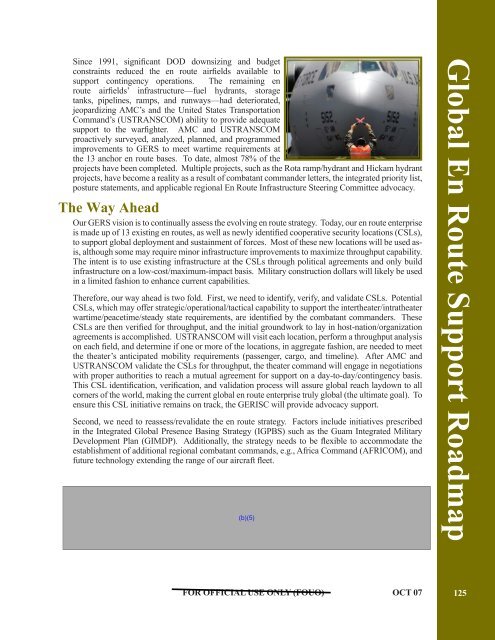Air Mobility Plan, 2008 - The Black Vault
Air Mobility Plan, 2008 - The Black Vault
Air Mobility Plan, 2008 - The Black Vault
You also want an ePaper? Increase the reach of your titles
YUMPU automatically turns print PDFs into web optimized ePapers that Google loves.
Since 1991, significant DOD downsizing and budget<br />
constraints reduced the en route airfields available to<br />
support contingency operations. <strong>The</strong> remaining en<br />
route airfields’ infrastructure—fuel hydrants, storage<br />
tanks, pipelines, ramps, and runways—had deteriorated,<br />
jeopardizing AMC’s and the United States Transportation<br />
Command’s (USTRANSCOM) ability to provide adequate<br />
support to the warfighter. AMC and USTRANSCOM<br />
proactively surveyed, analyzed, planned, and programmed<br />
improvements to GERS to meet wartime requirements at<br />
the 13 anchor en route bases. To date, almost 78% of the<br />
projects have been completed. Multiple projects, such as the Rota ramp/hydrant and Hickam hydrant<br />
projects, have become a reality as a result of combatant commander letters, the integrated priority list,<br />
posture statements, and applicable regional En Route Infrastructure Steering Committee advocacy.<br />
<strong>The</strong> Way Ahead<br />
Our GERS vision is to continually assess the evolving en route strategy. Today, our en route enterprise<br />
is made up of 13 existing en routes, as well as newly identified cooperative security locations (CSLs),<br />
to support global deployment and sustainment of forces. Most of these new locations will be used asis,<br />
although some may require minor infrastructure improvements to maximize throughput capability.<br />
<strong>The</strong> intent is to use existing infrastructure at the CSLs through political agreements and only build<br />
infrastructure on a low-cost/maximum-impact basis. Military construction dollars will likely be used<br />
in a limited fashion to enhance current capabilities.<br />
<strong>The</strong>refore, our way ahead is two fold. First, we need to identify, verify, and validate CSLs. Potential<br />
CSLs, which may offer strategic/operational/tactical capability to support the intertheater/intratheater<br />
wartime/peacetime/steady state requirements, are identified by the combatant commanders. <strong>The</strong>se<br />
CSLs are then verified for throughput, and the initial groundwork to lay in host-nation/organization<br />
agreements is accomplished. USTRANSCOM will visit each location, perform a throughput analysis<br />
on each field, and determine if one or more of the locations, in aggregate fashion, are needed to meet<br />
the theater’s anticipated mobility requirements (passenger, cargo, and timeline). After AMC and<br />
USTRANSCOM validate the CSLs for throughput, the theater command will engage in negotiations<br />
with proper authorities to reach a mutual agreement for support on a day-to-day/contingency basis.<br />
This CSL identification, verification, and validation process will assure global reach laydown to all<br />
corners of the world, making the current global en route enterprise truly global (the ultimate goal). To<br />
ensure this CSL initiative remains on track, the GERISC will provide advocacy support.<br />
Second, we need to reassess/revalidate the en route strategy. Factors include initiatives prescribed<br />
in the Integrated Global Presence Basing Strategy (IGPBS) such as the Guam Integrated Military<br />
Development <strong>Plan</strong> (GIMDP). Additionally, the strategy needs to be flexible to accommodate the<br />
establishment of additional regional combatant commands, e.g., Africa Command (AFRICOM), and<br />
future technology extending the range of our aircraft fleet.<br />
(b)(5)<br />
Global En Route Support Roadmap<br />
FOR OFFICIAL USE ONLY (FOUO)<br />
OCT 07 125
















